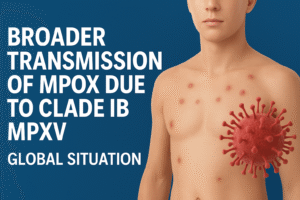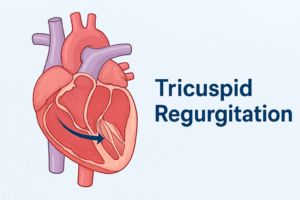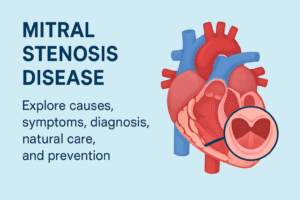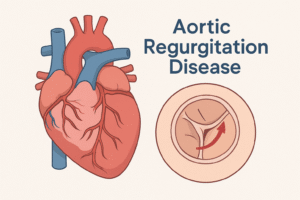Angina pectoris is chest pain or discomfort that occurs when the heart muscle does not get enough oxygen-rich blood. It is usually a symptom of underlying coronary artery disease (CAD), caused by narrowing or blockage of the coronary arteries due to atherosclerosis.
Key Features
- Pain described as pressure, squeezing, heaviness, tightness, or burning in the chest
- Discomfort may radiate to shoulders, arms, neck, jaw, or back
- Often triggered by physical exertion, emotional stress, cold weather, or heavy meals
- Usually lasts only a few minutes and is relieved by rest or nitroglycerin
Causes of Angina Pectoris
Angina occurs when the heart does not receive sufficient oxygen. Common causes include:
1. Coronary Artery Disease (CAD)
- Atherosclerosis: Fatty deposits narrow coronary arteries, limiting blood supply.
- Triggers: Symptoms appear more during exertion or stress.
2. Coronary Artery Spasm (Prinzmetal or Variant Angina)
- Temporary tightening of artery muscles reduces blood flow.
- Can occur even without significant blockage.
- Often happens at rest, especially early morning.
3. Increased Oxygen Demand
- Strenuous physical activity, stress, cold weather, or heavy meals increase the heart’s workload.
4. Reduced Oxygen Supply
- Severe anemia, low blood pressure, or respiratory diseases can cause insufficient oxygen delivery.
5. Other Causes
- Aortic stenosis (narrowed valve)
- Hypertrophic cardiomyopathy (thickened muscle)
- Uncontrolled high blood pressure
Classification (Canadian Cardiovascular Society)
- Class I: No angina with ordinary activity; only during heavy exertion.
- Class II: Slight limitation; angina on climbing stairs, after meals, or in cold weather.
- Class III: Marked limitation; angina on walking short distances or climbing one flight.
- Class IV: Severe; angina even at rest, unable to do physical activity without discomfort.
Symptoms of Angina Pectoris
Typical Symptoms
- Chest pain or discomfort (pressure, heaviness, burning)
- Radiation of pain to arms, neck, jaw, or back
- Shortness of breath during activity or stress
- Sweating and clammy skin
- Nausea or vomiting
- Dizziness or lightheadedness
Patterns of Occurrence
- Triggered by exertion, stress, heavy meals, or cold weather
- Relieved by rest or nitroglycerin within minutes
- Duration: Usually less than 20 minutes
Diagnosis of Angina Pectoris
Doctors use symptoms, medical history, and tests for diagnosis:
- History & Exam: Nature of chest pain, triggers, risk factors (smoking, diabetes, hypertension)
- Lab Tests: Lipid profile, blood sugar, cardiac enzymes
- ECG: Resting may be normal, but exercise stress ECG detects ischemia
- Imaging: Echocardiogram, nuclear stress test, coronary CT angiography
- Angiography: Gold standard to identify artery blockages
- Other Tests: CT calcium scoring, cardiac MRI
Stable angina is diagnosed with pattern recognition + stress tests + imaging.
Unstable angina requires urgent evaluation with ECG and angiography.
Treatment Without Medicine
Although medication is common, lifestyle management plays a major role.
1. Lifestyle & Diet Changes
- Eat a heart-healthy diet rich in vegetables, fruits, whole grains, and nuts.
- Limit salt, sugar, and unhealthy fats.
- Stay hydrated and limit alcohol.
2. Physical Activity
- Moderate daily exercise like walking or swimming (doctor’s approval needed).
- Always include warm-up and cool-down.
- Join cardiac rehab programs if prescribed.
3. Stress Management
- Practice yoga, meditation, and breathing techniques.
- Ensure 7–9 hours of sleep.
- Learn coping strategies for emotional triggers.
4. Avoiding Triggers
- Stay away from extreme cold or heat.
- Avoid sudden heavy exertion.
- Eat smaller, frequent meals.
5. Weight & Risk Control
- Maintain a healthy weight.
- Control cholesterol, blood pressure, and blood sugar.
6. Supportive Therapies
- Mindfulness and meditation
- Breathing exercises
- Omega-3 supplements (only under medical supervision)
Prevention of Angina Pectoris
- Quit smoking – reduces artery damage
- Adopt a heart-healthy diet – fruits, vegetables, lean proteins, healthy fats
- Stay active – 30 minutes of moderate exercise daily
- Manage conditions – keep diabetes, blood pressure, and cholesterol under control
- Avoid triggers – like cold weather exertion and heavy meals
- Regular checkups – early detection of heart disease risks
Global Impact of Angina Pectoris
1. Prevalence
- CAD affects ~126 million people globally (~1.7% of world population).
- Up to 50% of CAD patients experience angina.
2. Mortality & Morbidity
- CAD causes ~17.9 million deaths yearly (WHO, 2023).
- Angina reduces quality of life and increases hospital visits.
3. Economic Burden
- Billions spent on diagnosis, treatment, and surgeries.
- Indirect costs include lost productivity and disability.
4. Regional Trends
- High-income nations: Decline due to better prevention.
- Developing nations: Rising due to smoking, poor diet, and sedentary lifestyle.
- South Asia & Eastern Europe: Higher rates due to diabetes, hypertension, and smoking.
5. Public Health Significance
- Angina is an early warning sign of heart disease.
- Addressing it can prevent heart attacks and sudden deaths.
Frequently Asked Questions (FAQ)
Q1. Is angina the same as a heart attack?
No. Angina is temporary chest pain due to reduced blood flow, while a heart attack occurs when blood flow stops completely, causing heart muscle damage.
Q2. Can angina be cured?
Angina itself cannot be “cured,” but its symptoms can be controlled and risks reduced with lifestyle changes, medicines, or medical procedures.
Q3. How long does angina pain last?
Usually less than 20 minutes and often relieved by rest or nitroglycerin.
Q4. What are the main risk factors?
Smoking, diabetes, high blood pressure, high cholesterol, obesity, and family history of heart disease.
Q5. Can exercise help angina patients?
Yes, moderate exercise improves heart health. But always consult a doctor before starting an exercise plan.
Q6. Is angina always dangerous?
Stable angina is manageable, but it signals coronary artery disease. Unstable angina is dangerous and requires immediate medical care.






